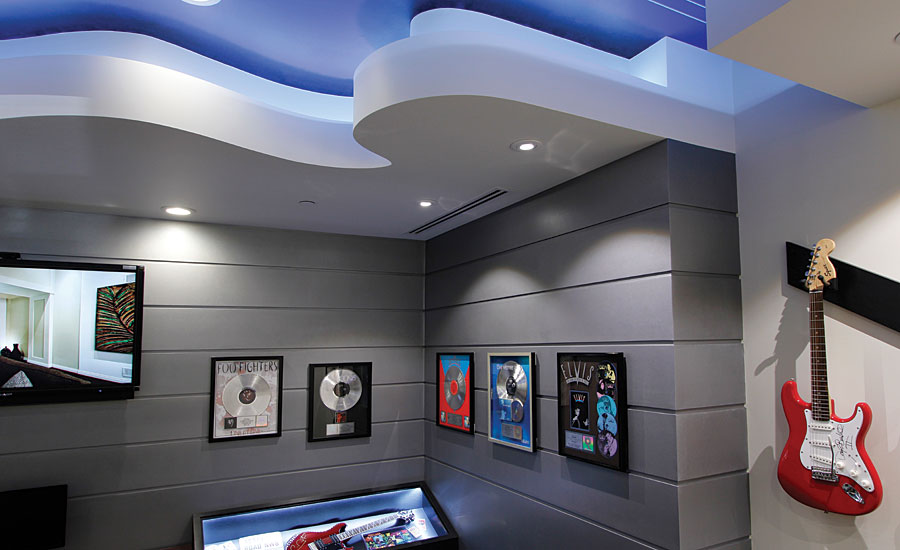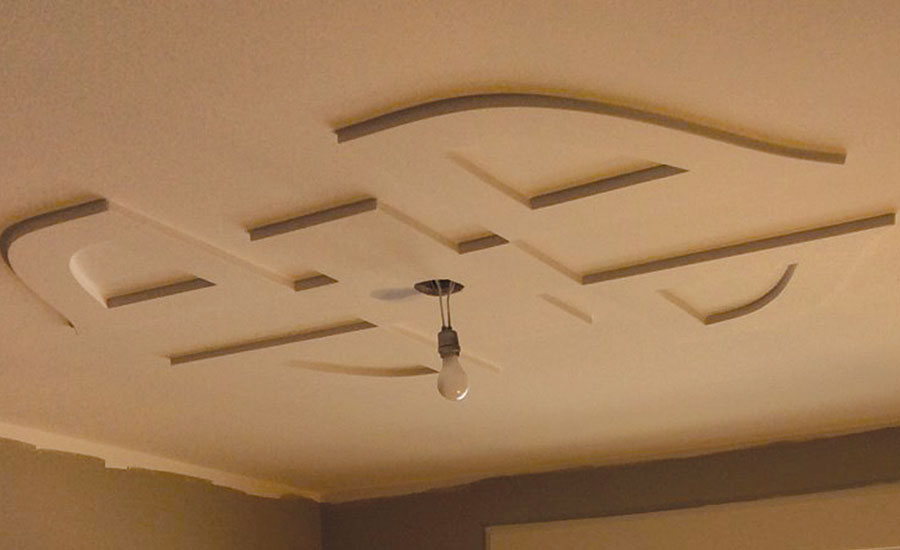Creating Drywall Art
Making drywall work an art form.


Kobetich uses staples to apply the bead onto the ceiling medallion.


This ceiling medallion is finished with two layers of drywall and accented with 1/2-inch by 1/2-inch Reveal Bead. The outside edges are finished with Chamfer Stop.

Custom finished medallions add unique details to homes.









Most people dream of waking up every day and loving their job—for some it’s not a dream—it’s their reality. Frank “Mudslinger” Kobetich, a drywall artist from Ontario, is one of the lucky ones who experiences great joy in his work as a drywall artist.
Kobetich began his drywall career more than 25 years ago doing standard taping jobs. However, that all changed after he attended a Trim-Tex Factory Trained Bead Technician course at the manufacturer’s Lincolnwood, Ill. facility. “Attending the class was the best decision for me at the time,” says Kobetich. “I was starting to get real bored of standard taping jobs.”
During the two-day course, attendees learned a variety of skills, including basic bead installation, how to create drywall art and tool usage. Kobetich left the course with new skills and a new direction for his career as a drywall artist.
It takes an especially skilled drywaller to become a drywall artist. Drywall art requires creativity to transform drywall products into one-of-a-kind home finishes.
“I’m always observing shapes and designs anywhere I happen to be and wonder what I might be able to do to make it my own,” says Kobetich. In addition to creativity, a drywall artist must possess a range of skills including carpentry, design, drywall finishing and most importantly, passion for the craft. Kobetich’s work is evidence that he possesses all these skills.
“Drywall art gives me something new and interesting to do and allows me to give people fresh ideas and designs. It has put some pep back in my step,” he says.
That Little Something Extra
Drywall finishers that learn drywall art are able to increase home values and provide services to homeowners and builders that can enhance rooms beyond standard drywall. “Learning drywall art gave me the knowledge, inspiration, confidence and the ability to do something extra nice for my customers. And make some more money, of course,” says Kobetich.
Nowadays you can find Kobetich working alone on his drywall masterpieces with a radio playing in the background, just the way he likes it. “I like my job a lot. In an odd way, it’s relaxing,” he says. Like the most skilled drywall artists, Kobetich can create a wide range of drywall art, anything from tray ceilings to window trimmings to medallions and everything in between. “I seem to be drawn towards creating subtle abstract medallions,” says Kobetich. “You really can’t go wrong making one. They are fun and challenging and look great just about anywhere.”
On a recent job, the home’s wide-open kitchen, dining and living area, allowed Kobetich to display his ability to create different types of drywall art. He included many features in the home, such as trimming windows with Niche Bead and Step A Bull, installing EZ Tray in the kitchen to beautifully accent the cabinets and creating unique art by using fixtures already present in the home. “It’s fun to see strange looks from people when you first get started doing something different,” he says. “Then as the work progresses and they can see the finished product they start to smile.”
Creating the Look
In honor of Kobetich’s favorite creation, the ceiling medallion, here are the steps he takes to create his medallion masterpieces.
To begin, Kobetich sketches out the medallion design on a drywall sheet or leftover scraps. Sketches can also be done on paper and then transferred to the drywall. Many finishers are intimidated by sketching, but shouldn’t be. “I think the biggest challenge to creating drywall art for me is the fact that I was never an artsy or creative person,” says Kobetich. “I don’t design anything on paper because I don’t draw very well. I’m learning that none of that really matters!” Since a ceiling medallion is a layered detail, each layer needs to be sketched separately. Ceiling medallions are typically made up of two or three different layers.
When designing the medallion it is important to consider different bead choices, the layout of the room and design preferences. Beginning drywall artists will typically find success using L Bead or Archway L Bead for curved designs. The soft curves that can be created with Archway L Bead and 350 Bull L Bead accent a warm, cozy space. On the opposite end of the design spectrum, L Bead can be used to create a clean modern feel. These are just a few bead options that can be used on ceiling medallions. Kobetich likes to incorporate Niche Bead and Step A Bull into his creations. “They really are pleasing to the eye,” he says.
Strategic placement of custom medallions can accent lighting fixtures or kitchen cabinets and add flair to plain ceilings. “I come up with ideas by using existing pot lights or other fixtures to create something unique on every drywall art job,” says Kobetich.
Once a design has been sketched, the next step is to cut out the various layers from the drywall piece, arrange the pieces together and screw the layers into place. Then cut and dry-fit all the beads to ensure they fit correctly. Kobetich uses Trim-Tex beads, which are installed with spray adhesive and staples. With the beads installed screw the medallion into place, securing it by screwing into roof or floor joists. The medallion is now done and ready to be mudded and sanded.
Looking for a reprint of this article?
From high-res PDFs to custom plaques, order your copy today!










